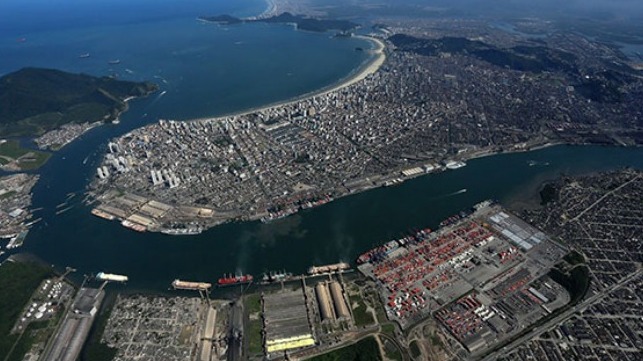Calls for Brazil to Adopt Virtual Arrival to Reduce Port Congestion

Unprecedented congestion in Brazil’s ports is impacting commodities exports and contributing to a surge in global prices. It is leading to a call from the shipping industry and commodities companies to adopt new, more efficient methods for managing ship arrivals.
As the number of ships waiting to load across major southern ports increases, and shipping lines including Maersk continue to issue customer advisories on delays, the trade group BIMCO issued a call for the world’s largest grain exporter to adopt virtual arrival or just-in-time systems, a strategy that they believe can significantly reduce waiting times for vessels and lead to large savings in bunker costs and carbon emissions.
BIMCO highlights that congestion for ships loading grain cargoes at Brazilian ports has surged this year. During the 11 months to November, the average waiting time for vessels reached 15 days, up from an average of nine days between 2018 and 2022. It is also well above the global average of five days in 2023 for grain loading.
The problems in the grain operations are also spilling over into the broader port operations. Owing to the worsening pileup of vessels, Maersk for example this week issued its ninth advisory in three months. On December 11, the second biggest shipping company informed customers of delays across the ports of Navegantes, Paranagua, and Itapoa with vessels facing extended delays.
“Regrettably, we are unable to provide a specific timeline for normalization due to adverse weather conditions expected in the upcoming days,” said Maersk in its latest advisory.
Because Brazil is the world’s largest grain exporter, accounting for 24 percent of the world’s exports in 2022, the country is witnessing unprecedented port congestion due to large grain harvests this year. The lack of enough storage facilities has also forced farmers to increase exports thus overloading the ports. The situation worsened starting in September when low water levels in the Amazon disrupted shipping in the northern part of the country. With grain exports expected to remain strong, the country is looking at a prolonged period for its port crisis.
To deal with the crisis, BIMCO is calling on Brazilian authorities to adopt virtual arrival for vessels. In its analysis, the industry trade group reports that currently, ships are only allowed to join a queue to dock upon arrival, forcing them to sail at regular speeds despite the congestion ahead. However, if ships were permitted to enter the queue before arrival, they could opt for slower sailing speeds, thereby saving significant amounts of fuel and reducing their carbon emissions.
“Virtual arrival is a solution for ships arriving in ports with known delays. It allows ships to adjust their speed during a voyage to arrive just in time at the port. The ship ‘virtually arrives’ at the time scheduled had it continued at the original speed, and demurrage or other detention charges are adjusted accordingly,” explains Filipe Gouveia, Shipping Analyst at BIMCO.

that matters most
Get the latest maritime news delivered to your inbox daily.
He concedes that “just-in-time” involves precise scheduling and coordination to ensure that a ship arrives at the port exactly when it's needed. BIMCO noted in a paper on the issue that despite its benefits, adopting just-in-time arrivals has proven very difficult to implement due to a lack of support from terminals, cargo owners, and other stakeholders involved in a port call.
During the surge in volumes and a pileup of vessels in its anchorages, the groups controlling the Southern California ports introduced an advance booking system that they believe has been highlight successful. Containerships are registering when they depart Asia and can then slow steam the Pacific. The system was introduced along with a voluntary prohibition on anchoring or loitering near shore to reduce near port emissions.
The Marien Exchange of Southern California reports that 17 containerships are due to arrive at the ports in the next three days with all of them going directly to their berths. The system was introduced for Southern California in November 2021 and as a result, they highlight congestion has returned to pre-COVID 2018-2019 levels with none or one containership at anchor on most days. On 14 of the past 31 days, there have been no containerships in the combined anchorage for the ports of Los Angeles and Long Beach while there are currently approximately 40 vessels registered and managing their crossing to optimize operations.
